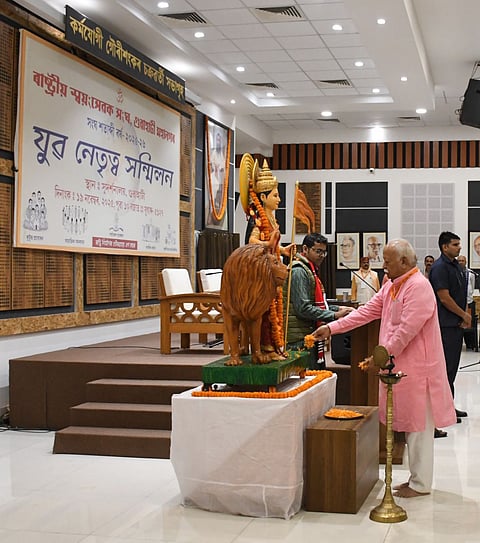
- Home
- Live Blog
- Breaking News
- Top Headlines
- Cities
- NE News
- Sentinel Media
- Sports
- Education
- Jobs

Debika Dutta
(debika.dutta2015@gmail.com)
Dr Mohan Bhagwat’s address at the Pramukh Nagarik Sanmilan in Gu wahati was not merely an organizational event; it was a deliberate articulation of civilizational thinking at a time when Bharat is renegotiating its sense of self. His speech, sober in tone yet firm in conviction, sought to place contemporary debates within an older, deeper matrix of cultural continuity.
At the heart of his message lay an idea central to the RSS worldview: that the term “Hindu” must be understood not as a religious marker but as a civilizational identity. His assertion that “anyone who loves Bharat is a Hindu” carried no hint of rhetoric. Instead, it attempted to recover the broader meaning the word once held—signifying cultural belonging, shared memory, and a familiar rhythm of life shaped by this land. In Guwahati, this framing appeared neither exclusionary nor doctrinaire; it was offered as a way of recognising unity beneath visible diversity.
Equally important was his reminder that Bharat does not need a legal designation to become a Hindu Rashtra. The cultural instincts of the nation—its philosophical traditions, moral imagination and lived pluralism—already reflect a civilizational character that long predates modern politics. This distinction between constitutional form and cultural ethos is one the Sangh frequently reiterates, and in the Northeast it found a receptive audience attuned to questions of identity and belonging. Throughout his speech, Dr Bhagwat returned to Vyakti Nirman, the shaping of the individual, as the enduring centre of the RSS’ work. Despite the organization’s visible outreach and expansion in the region, he emphasized that transformation begins not with political mobilisation but with personal discipline, character-building and an ethic of service. For a rapidly changing society, this call for internal anchoring felt particularly relevant.
Within this framework, his articulation of the Panch Parivartan—social harmony, family awakening, civic responsibility, self-reliance and environmental consciousness—assumed practical significance. These were presented not as ideological abstractions but as responses to tangible shifts: weakening family bonds, shrinking community spaces and rising socio-economic aspirations. His emphasis on self-reliance resonated with the country’s economic trajectory, while the call for ecological sensitivity aligned seamlessly with the civilizational respect for nature embedded in Bharatiya thought.
In acknowledging Assam’s cultural lineage, Dr Bhagwat placed Lachit Borphukan and Srimanta Shankardeva within the longer continuity of Bharat’s civilizational story. This was more than a tribute; it was a gesture of integration that recognised the Northeast’s role in shaping the national imagination. Assam’s history of cultural assimilation, spiritual innovation and civilizational resilience sits naturally within the broader narrative he sought to underline.
On sensitive concerns such as illegal migration and demographic imbalance, his tone remained cautious and measured. He voiced long-standing anxieties of the region without resorting to alarmism, and his mention of a voluntary three-child norm for Hindus was framed in terms of societal stability rather than confrontation. With fertility patterns steadily converging across communities in Assam, the complexity of demographic questions requires exactly this calibrating balance between vigilance and restraint.
His warning on misinformation and the disruptive power of social media found particular resonance in the Northeast, where layered identities and historical grievances often make public opinion sensitive to digital manipulation. Dr Bhagwat’s appeal for responsible engagement underscored a contemporary reality: that maintaining harmony today depends as much on online behaviour as on the civility of everyday life.
On historical interpretations, the Sarsanghchalak sought to revisit the narrative surrounding the RSS’ role in the freedom movement. By referencing Dr Hedgewar’s participation in early national movements and the presence of swayamsevaks in the Quit India phase, he pushed back against readings that minimise the organization’s contribution. While scholarly debates will continue, his message was clear: the Sangh sees itself as an intrinsic participant in the country’s struggle for dignity. His portrayal of the Northeast as a living expression of unity in diversity reflected both appreciation and caution. The region’s cultural richness and instinctive sense of community have long contributed to the national mosaic, yet its internal diversities demand understanding and sustained engagement. Dr Bhagwat acknowledged this complexity, hinting at a future where the region’s voice occupies a more prominent place in the civilizational narrative.
Ultimately, the Guwahati address reflected a Sangh confident in its philosophical grounding yet aware of India’s plural realities. Dr Bhagwat offered a civilizational vocabulary without provocation, a call for rootedness without rigidity and a narrative of unity without erasure. In a time when discussions on identity often lean towards polarity, his intervention favoured depth over decibels. As the RSS steps into its centenary decade, the ideas outlined in Guwahati are likely to shape how the organization imagines the future—and how debates on nationhood evolve in the years to come. His message did not seek to prescribe a political course; it sought to remind a society in transition of the inheritance on which it stands.